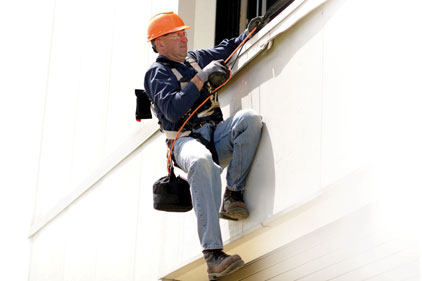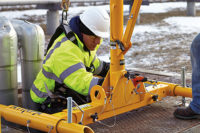When things go wrong when working at height, no matter if it is 10 or even 300 feet in the air, it’s too late to fine-tune your rescue plan. You have just minutes to rescue a worker before suspension trauma can occur. Research indicates that suspension in a fall arrest device can result in unconsciousness, followed by death, in less than 30 minutes.1
If someone needs to escape or be rescued, do you have a plan in place?
Has that plan been tested?
To assist with escape and rescue of workers on towers, cranes, platforms, scaffolding, aerial lifts, rigs and other at-height environments, it is vital to have the right plan in place. Calling 911 and relying on first responders isn’t an effective rescue plan because they may not have the resources to perform a timely rescue at height. Further, the Code of Federal Regulations requires all employers to have a rescue plan.
This underscores the need for employers to have their own plans for the prompt rescue of workers in the event of a fall and to ensure that workers are able to rescue themselves or be rescued by an internal team.
Factors to consider
When developing a fall protection escape and rescue plan, consider these factors:
- Regulations & standards – what is the industry requirement?
- Best practices – what have other companies found to be most effective?
- How many employees work at height?
- At what height(s) would employees need to escape or be rescued?
- How quickly do they need to escape or be rescued?
- Are external resources available or only internal?
- Are roles clearly defined to ensure employees responsible for rescue are aware of this responsibility?
- Has training on escape and rescue products been completed?
- Equipment inspection guidelines
What do safety standards say?
Looking at regulations from the standards bodies, here are OSHA’s rescue plan
requirements:
OSHA 1926.502 (d)(20): The employer shall provide for prompt rescue of employees in the event of a fall or shall assure that employees are able to rescue themselves.
OSHA refers to rescue throughout its regulations such as in OSHA 1910.66 Appendix C Section III.(g): “Rescue considerations.” As required by the standard (Section I Paragraph (e)(8)), when personal fall arrest systems are used, the employer must assure that employees can be promptly rescued or can rescue themselves should a fall occur. The availability of rescue personnel, ladders or other rescue equipment should be evaluated. In some situations, equipment which allows employees to rescue themselves after the fall has been arrested may be desirable, such as devices which have descent capability.
Further, Canadian OHS requirements dictate: Written rescue procedures must be in place and executed before any use of a fall arrest system. A rescue plan is required for any person at height.* Legislation standards require that where a worker is exposed to the hazard of falling more than 3 meters, the worker will wear a serviceable safety belt or harness and lifeline so the worker cannot fall freely for a vertical distance of more than 1.5 meters; and before any use of a fall arrest system, the worker’s employer shall develop written procedures for rescuing the worker after his or her fall has been arrested.**
Rescue options
Beyond having a plan on paper, it must translate into real-world scenarios by being user friendly. Rescue options must be thoroughly thought out and practiced so that if and when an incident occurs, workers have actually gone through the steps required to perform the rescue. If your plan indicates employees will perform an escape or self-rescue, an assisted rescue or even rapid sequential evacuation, do they know how to actually perform these types of procedures?
Selecting equipment
When putting together a fall protection escape and rescue plan, equipment is a major factor. Products must be easy to use and workers must practice using them on a regular basis to ensure they can perform an escape and/or rescue for themselves or for a co-worker.
To simplify the selection process, here are some criteria to consider:
1) What speci?c capabilities are needed?
Escape — individual and/or multi-person
- For individual escape, consider devices that can be carried and pre-rigged so they’re ready when needed.
- To safely evacuate multiple people from high places, one after another, consider a device that does not require re-rigging between descents.
Assisted rescue
t If the user is not able to self-rescue (e.g. if unconscious), some devices can be rigged for victim rescue, giving complete control to the rescuer, ensuring the victim is lowered to safety quickly and easily.
Self-rescue after a fall
- Consider a device to allow a worker to lower themselves to a safe location after their fall has been arrested.
2) Depending upon the work environment, there may be a need to have specialized equipment. These environments may include:
- General Industrial/Manufacturing
- Tower Climbing
- Oil & Gas
- Mining
- Construction
- Utilities/Bucket Trucks
- Consider a device that meets the particular needs of the market, e.g. descent speed, triple lock carabiners, weight of equipment, etc.
3) Are there hazards that could jeopardize the safety of the worker during an escape or rescue descent?
- Consider a device that allows the user to stop, go and change speed at any time during the descent to help avoid hazards.
Plan ahead to save lives
Thoughtful fall protection escape and rescue planning must be top-of-mind for organizations with workers at any height. With advance planning, user-friendly escape and rescue equipment and procedures after a fall can save lives. Take all these factors into consideration as you develop a plan to ensure the safest operation possible for the benefit of your workers.





